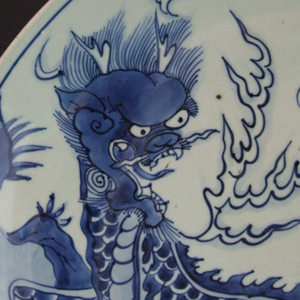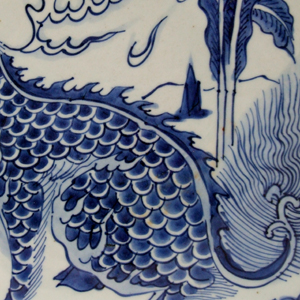
SHUNZHI 1644 – 1661 Transitional Porcelain
A Fine Transitional Porcelain Blue and White Dish, Early Qing Dynasty, Shunzhi Period 1644-1661 The Thickly Potted Porcelain Saucer Shaped Porcelain Dish is Vigorously Painted in Blue and White in the `High Transitional` Style with a Dramatic Fire Breathing Qilin (Kylin) in a Landscape with a Banana Plant. The Rim Dressed with Iron-Oxide and the Base with a Four Character Mark Yu Tang Jia Qi (“Fine Vessel for the Jade Hall”). The Back is Marked Using a Diamond Point with the Chinese Family Name of the Person that Owned this Dish a One Time.
SOLD
- Condition
- Damaged : a large rim crack c.76 mm. Some general wear to the glaze. Some light fritting.
- Size
- Diameter : 36.2cm (14 1/4 inches)
- Provenance
- N/A
- Stock number
- 23599
- References
- For a Shunzhi blue and white porcelain dish of this design see : Shunzhi Porcelain, Treasures from an Unknown Reign (Butler, Curtis and little, University of Washington Press,2002) page 108, item 13. For another dish of this type decorated with this design see : Eastern Ceramics and other Works of Art from the Collection of Gerald Reitlinger, Catalogue of the Memorial Exhibition (Ashmolean Museum, Sotheby Parke Bernet, 1981. ISBN 0-90009-078-2) Mis-dated as being early Kangxi c.1680-1700, page 49, plate 98. For a very similar Transitional blue and white porcelain dish with this design see : Chinese Decorative Arts and Export Porcelain, Sotheby`s London, 28th October and 1st Novemmber 1988, lot 440. For a further Transitional porcelain of this design and shape, dated to c.1655-1670, see : Seventeenth-Century Blue and White Porcelain and Copper-Red and Their Predecessors (Exhibition Catalogue, S Marchant & Son, London,June 1997) page 48, plate 46. For a Blue and White Transitional Porcelain dish of this design see 22135 and 22650. For a jar with similar Qilin see 17570 and 21409 in our `Sold` items.
Information
"Fine Vessel for the Jade Hall" :
This four character mark found on some late Ming porcelain was very popular during the Shunzhi Period of 1644 - 1661. It frequently occurs on a group of thickly potted saucer shaped dishes of a type that was popular during Shunzhi`s reign. According to Michael Butler (Shunzhi Porcelain, Treasures from an Unknown Reign, Butler, Curtis and little, University of Washington Press,2002) Terese Tse Bartholomew in her book Myths and Rebuses in Chinese Art refers to "Jade Hall" as a wealthy establishment, and also an elegant name for the Hanlin Acadamy, an official bureau made up of scholars who had attained the highest degrees (politically relevant since the jinshi degree was reinstated by the new regime in 1646.
Qilin or Kylin.
A Qilin (Kylin) is a mythical hooved Chinese chimerical creature. Despite its fierce demeanour it is a good omen that brings Rui (roughly translated as `serenity` or `prosperity`), longevity, illustrious offspring and wise administration. The scaly body has a dragons head, hooves and can appear to have fire issuing from its body. The male Qilin is called a Qi and the female a Lin. The male often has horns. These creatures carefully tread to avoid all living insects or destroy grass under foot, it is reputed to be able to walk on water as well as land. Qilin only appear to mankind when an emperor of the highest benevolence sits on the throne or when a sage is about to be born. There is a strong argument that the Qilin is a stylised representation of the giraffe. This is because the Qilin is referred to only since the Ming Dynasty. The time of its first reference correspond roughly with the voyages of Zheng He, there were seven voyages between 1405 and 1433 (Zheng He lived c.1371–1435). It is known that on Zheng He`s voyage to East Africa (landing, among other places, in modern-day Kenya), the fleet brought back two giraffes to Beijing. It is also known that these two giraffes were referred to as Qilins. The Emperor proclaimed the giraffes magical creatures, whose capture signalled the greatness of his power.
Shunzhi :
Shunzhi was emperor of Manchuria between Oct. 8, 1643-Oct. 30, 1644. Officially proclaimed emperor of China on Oct. 30, 1644. Shunzhi (March 15, 1638–February 5, 1661?) was the second emperor of the Manchu Qing dynasty, and the first Qing emperor to rule over China, his reign was from 1644 to 1661.
The Transitional Period.
The roots of this unsettled period starts during the later part of Wanli`s reign (1573-1620). At the begging of his reign China was doing very well, new crops from the Americas such as peanuts, maize and sweet potatoes increased food production, while simplified taxes helped the state run smoothly. But this was not due to Wanli`s enlightened reign, but to his Mother championing a man that was to become the Ming dynasties most able minister, Zhang Zhuzheng (1525—1583). Wanli became resentful of Zhuzheng`s control but upon his death became withdrawn from court life. Between 1589 to 1615 he didn`t appear at imperial audiences, leaving a power vacuum that was filled by squabbling ministers. Mongols from the North raided as Japan invaded Korea. Wanli re-opened the silver mines and imposed new taxes but the money was lost due to corruption, as well as being frittered away by the indulgent Emperor himself . The next emperor of Ming China, Tianqi (1621-1627), was bought up in this self indulgent disorganised environment, at the very young age 15 his short reign started. He didn`t stand a chance. Tianqi made the mistake of entrusting eunuch Wei Zhongxian (1568-1627) who Anna Paludan in her excellent book "Chronicle of the Chinese Emperors" (Thames and Hudson, 1998) describes as "a gangster of the first order". Tianqi was deemed to have lost the Mandate of heaven by the Ming people. Tianqi`s younger brother, the last of the Ming Emperors, Chongzhen (1628-1644), was not able to save the situation. The systems of administration had broken down, corruption was rife and so when a sever famine broke out in 1628 nothing much could be done. Anna Paludan describes the tragic end to the great Ming Dynasty "The final drama was worthy of a Greek tragedy. The emperor called a last council in which `all were silent and many wept`, the imperial troops fled or surrendered, and the emperor, after helping his two sons escape in disguise, got drunk and rushed through the palace ordering the women to kill themselves. The empress and Tianqi`s widow committed suicide; the emperor hacked off the arm of one daughter before killing her sister and the concubines. At dawn he laid his dragon robe aside and dressed in purple and yellow, with one foot bare, climbed the hill behind the now silent palace and hanged himself on a locust tree". The Great Wall of China, started 2,000 years ago was built to protect China from the Northern barbarian hoards, it was often tested and sometimes failed. The Jin people invaded China, ruling the North between 1115 and 1234, it was their descendants the Manchus, Jurchens from south east Manchuria that took full advantage of the problems of the Ming dynasty. In 1636 they adopted a Chinese dynastic name, the `Great Qing` (Qing meaning pure). The first of the Qing emperors was Shunzhi (1644-1661) but for most of his reign his uncle ran the state. War raged on during this period and it wasn`t until the second Qing emperor Kangxi (1662-1722) that true peace was achieved. Kangxi was a wise and educated man, he became a highly successful emperor bringing China a long period of wealth and stability.




